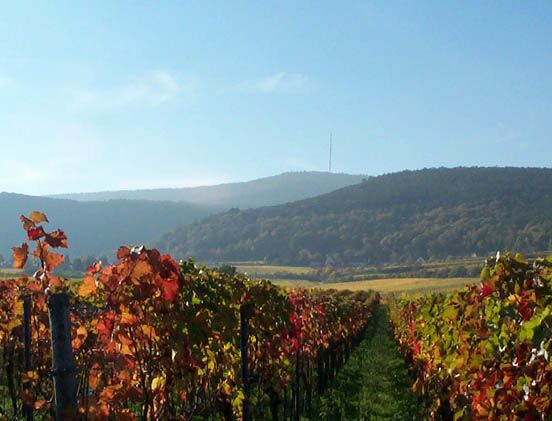- Palatinate (wine region)
Infobox Wine Region
name = Palatinate

official name =
other name = Pfalz
wine years = Since 1st century AD
country = Germany
part of =Rhineland-Palatinate
sub regions =
climate region =
heat units =
precipitation =
soil =
total size =
planted = 233.4 km ²
vineyards = 350
grapes =
varietals =
wineries =
wine produced =
designation =
comments = 2.5 million hl produced annuallyPalatinate ( _de. Pfalz) is a
German wine -growing region ("Weinbaugebiet") in the area ofBad Dürkheim ,Neustadt an der Weinstraße , andLandau inRhineland-Palatinate . Before 1993, it was known as Rhine Palatinate ("Rheinpfalz"). With convert|23353|ha under cultivation in 2006, the region is the second largest wine region inGermany afterRheinhessen . [http://www.deutscheweine.de/icc/Internet-DE/med/1a6/1a64f607-a3e5-5117-3d28-952196117f51,11111111-1111-1111-1111-111111111111.pdf German Wine Institute: German Wine Statistics 2007-2008] ] There are about 6,800vintner s producing around 2.5 millionhectolitre s of wine annually.History
Although wild varieties of the vine were most probably native in the Palatinate region the Romans brought the cultivated vine and winegrowing techniques around 1 A.D. Several Roman landhouses (villa rusticae) were found in the Palatinate region, for example near
Wachenheim andUngstein .The "
Flurbereinigung " restructuring of the 1980s raised the quality of the area's vineyards to modern standards and by the end of the 20th century, Palatinate wines were garnering international notice for their quality. J. Robinson (ed) "The Oxford Companion to Wine" Third Edition pg 516-517 Oxford University Press 2006 ISBN 0198609906 ]Climate and geography
The Palatinate wine region overlaps with, but is not coextensive with, the traditional German region of Palatinate, making up only 5% of its area. The
wine region is an 80-km stretch situated under the lee of thePalatinate Forest on theHaardt Mountains , a continuation ofAlsace 'sVosges Mountains . Its climate is much like that of Alsace and it is the sunniest and driest of German wine regions. The vineyards are planted on a mixture ofsandstone andvolcanic soil.Wine regions
The region is divided into two districts ("Bereich"), "
Südliche Weinstraße " (Southern Wine Route) in the south and "Mittelhaardt-Deutsche Weinstraße " (Central Haardt-German Wine Route) in the north. The Northern vineyard are located north ofNeustadt an der Weinstraße in a region often listed on wine labels as "Mittelhaardt" and includes the towns and villages of-
*Bad Dürkheim
*Deidesheim
*Forst an der Weinstraße
*Freinsheim
*Kallstadt
*Ruppertsberg
*Wachenheim
*Ungstein
*Lambsheim
*Kirchheim
*Bockenheim The Southern region located south of Neustadt an der Weinstraße has significant plantings of the varieties
Grauburgunder (Pinot gris) andWeissburgunder (Pinot blanc) but also produces someRiesling . The soil here ranges from sandstone toslate . The region includes the villages of-
*Birkweiler
*Burrweiler
*Frankweiler
*Siebeldingen
*Rhodt Grapes and wine
There are 45 white and 22 red grape varieties permitted to grow in the Palatinate. Overall the production is approximately split between 60% white wine and 40% red wine. For many years the dominant grapes of the region were the
Müller-Thurgau , Kerner andMorio Muscat with Riesling always having a strong foothold in the Mittelhaardt. Toward the end of the 20th century, plantings of Riesling began to increase in the south as well as an increase in plantings of red wine varieties such asSpätburgunder (Pinot noir),Portugieser andDornfelder .The wines of the Palatinate are traditionally dry ("
trocken ") with a full body, though some examples of sweet Portugieser still exist. The red wines often reachalcohol levels of 13% and go throughmalolactic fermentation and spend some time in oak. Since the 1990s there has been increased production in the sparkling wine (Sekt ) made from Riesling.Culture
Unlike in other German wine regions, wine is served in 50cl glasses called "Schoppen" (meaning 1/2 litre) as well as in the typical 25cl ones called "Viertel" (meaning 1/4 litre). They are of a special shape specific to the region and are known as the "Dubbeglas", widening from bottom to top and featuring indentations or large dimples ("Dubbe") that give the glass its name. The undimpled cylindrical half-litre "Schoppenglas" is also frequently seen in the region. The
German Wine Route ("Deutsche Weinstraße") traverses this wine region. The region also produces spirits,sparkling wine s, winevinegar , andgrape seed oil .References
External links
* [http://www.pfalzwein.de/en/ Pfalzwein] official site en icon
See also
*
German Wine Route
Wikimedia Foundation. 2010.
